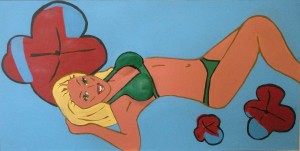Contemporary Art Exhibit Revisits a Founder of the Movement

Stereotype and cliche are to Marjorie Strider as Istanbul is to Orhan Pamuk or the chador to Shirin Neshat. They are goads to her art.
She first came to art world attention in the 1965 “International Girlie Show,” with her blandly outrageous bikini girls flaunting their flawless suntans and smiling their Ipana smiles. They were the goddesses of airbrushed Playboy fantasy exposed as vapid and bloodless, sisters to the Barbie Dolls then relatively new to the market.
Strider turned the male gaze back upon itself as a sock in the eye. This is what you want, I’ll give you what you want, those beauties seemed to declare in an exhibition that included such big boys as Roy Lichtenstein, Tom Wesselman and Andy Warhol—no slouches at the ironic cultural knockout themselves.
But Strider’s bikini girls raised the stakes even higher. They took on the more orthodox stereotypical sanctity of painting itself. Her acrylic paintings on wood panel disdain categorization, crossing the line into sculpture. Their breasts are painted wooded wedges, roughly the shape of the sole of a shoe, applied to the surface of the painting in primitive sculptural relief.

Strider revisited the theme of her bikini girls in 2009, and they are included in a selection of her works from 1981 and 2009, which is on view at the Bridge Gallery on the Lower East Side of Manhattan, through May 11. (The dating of some of these works is so vague, however, that it is also possible that some of the bikini girls at the gallery were made earlier. Or not. The checklist notes “We are unclear when she returned to creating them.”)
Strider, who like so many of the women of her generation was largely eclipsed by the men, has been receiving a well deserved second look of late. This exhibition permits a revisionist take on art that had seemed more politically engaged than formally inventive at the time. It took Frank Stella another two decades to discover the Baroque possibilities of painting that thrust from the wall into the viewer’s space.
Elizabeth Murray made her transition from sculpture to planar painting in the late 1960s, soon after Strider. The two painters share a spirit as rebellious as it is inventive. “The word being spread was, ‘Haven’t you heard? Painting is Dead!,’ “ Murray once explained. “I thought, Really? Well, to hell with that, I’m painting!”
But their approaches are wildly different. Murray burlesqued the comforts, chaos and tragedy of daily domesticity with the animated absurdity of a cartoon. Strider tilts at stereotypes with an unlikely fusion of abstract expressionism, folk art and the in-your-face language of advertising.

Her most blatant cliche of a cliche in the exhibition, and her most direct homage to folk art, is the 1981 painted metal sculpture “Florida.” Two elegantly striding pink flamingos are the legs of a table which holds two smaller flamingoes, dwarfed, like an Easter bonnet, by tropical flowers.
In her paintings of the 1990s, she is fierce and urgent. The acrylic on board painting “Untitled 1993″ is Strider at her tempestuous best. Primitive flames score the surface and leap off the edge, yellow, blue, red and white at the left, blue and green and scumbled at the right. A black and white shape hooks and snakes its way from the center, slithering off the bottom of the painting. Snakes are a constant theme in these paintings for their formal and psychological possibilities, usually in bright, pulsating colors.
In Strider’s strident abstractions, surfaces are raked with ribbons of color and often as studded as a votive cross with sequins, dressmaker baubles, tin Virgin Marys or crudely fashioned toy figures. The Mexico of “Mexico (floral),” from 1994 is Mexico as tourist cliche, here presented as a dream of peasants, flowers, fringe and boisterously printed fabric.
There’s anger in the depiction, but celebration too. Strider infuses the limpest banalities with the messy exuberance of life.
By Amei Wallach, Contributing Writer